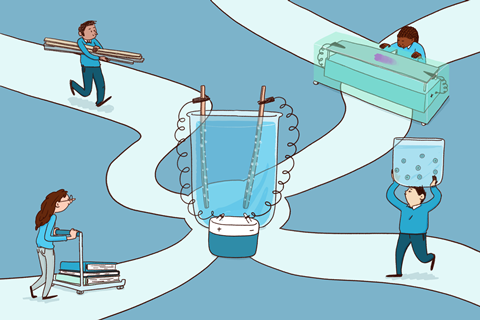Use multiple practicals and demonstrations to help students really grasp a concept
What is Paris? Paris is the capital of France. But it is also a city located in Europe, it’s home to the Eiffel Tower, to buttery croissants and to police cars with a distinctive siren. The answer then to ‘what is Paris?’ depends on the information you have learned about this city, but also the encounters you have had with this city.
Thinking about chemistry is similar. What is electrolysis? You might give a definition or write an equation, but electrolysis is far more than that. It is a process involving smells, colour changes and bubbles of gas that bear no resemblance to the compounds they came from.
Practical science plays an important role in setting up such encounters between students and the chemical concepts they are learning about. A variety of approaches to practical science can improve understanding of theory – it will help students construct an understanding of concepts in all their dimensions.
7 simple rules to boost science teaching
Click to expand and explore the rules
Build on the ideas that pupils bring to lessons
Help pupils direct their own learning
Use models to support understanding
Support pupils to retain and retrieve knowledge
- Pay attention to cognitive load—structure tasks to limit the amount of new information pupils need to process
- Revisit knowledge after a gap to help pupils retain it in their long-term memory
- Provide opportunities for pupils to retrieve the knowledge that they have previously learnt
- Encourage pupils to elaborate on what they have learnt
Use practical work purposefully and as part of a learning sequence
Develop scientific vocabulary and support pupils to read and write about science
Use structured feedback to move on pupils’ thinking
Planning for multiple encounters
Below, I’ve described how various approaches to practical science can help to portray electrolysis in the classroom. Each encounter encourages students to think about the fundamental conceptual levels in which chemistry operates: the macroscopic and the sub-microscopic. For each, I’ve outlined how chemists tend to represent the chemical event and how this representation serves as a bridge between the macroscopic and the sub-microscopic levels. Students need to understand, for example, that NaCl(s) can represent both a lump of salt (macroscopic) and individual ions within an ionic lattice (sub-microscopic).
Approach: Simulation or animation of ions dissolving in water
Encounter: Show a PhET simulation of ions moving randomly when added to water.
Representation: NaCl(s) → Na+(aq) + Cl-(aq)
At the same time as showing the simulation, demonstrate dissolving. Draw links between the simulation, your demonstration and the equation.
Approach: Demonstration of ions moving
Encounter: Place a crystal of purple potassium manganate(VII) on a wet strip of filter paper, apply a DC voltage across the paper and see the purple manganate(VII) ions move towards the positive terminal. Find full details for the experiment on Learn Chemistry.
Representation: KMnO4(s) → K+(aq) + MnO4-(aq)
Annotate the filter paper with a pencil to show the movement and formulas of ions.

Approach: Class practical making oxygen and copper
Encounter: Making substances is an important role for practical work. In the electrolysis of copper sulfate solution students get to ‘see’ elements, or at least test for them. Let students copper plate metal objects supplied by the school. Find full details for the experiment on Learn Chemistry.
Representation:
Anode: 2H2O(l) → O2(g) + 4H+(aq) + 4e-
Cathode: Cu2+(aq) + 2e- → Cu(s)
Relate the equations to the macroscopic observations eg bubbles formed would be O2(g).
Approach: Virtual experimentation using different metal electrodes
Encounter: Students set up a virtual experiment to explore what happens at the macroscopic and sub-microscopic levels during electrolysis involving different metal electrodes. Find full details for the experiment at ChemDemos.
Representation:
Anode: Cu(s) → Cu2+(aq) + 2e-
Cathode: Cu2+(aq) + 2e- → Cu(s)
Students complete the virtual experiment before actually doing the practical in class. Pose questions that encourage students to consider how the virtual experimentation helped them to make sense of the macroscopic observations (or not!).
Approach: Open-ended project to explore the effects of changing variables or to solve a particular challenge
Encounter: Students can choose to investigate a specific aspect of electrolysis, for example changing the concentration of solutions or temperature and record changes in current.
Or set an open challenge where students use electrolysis, and other methods, to identify which solid is copper sulfate and which solid is copper chloride.
Representation: Encourage the use of both macroscopic observations and sub-microscopic explanations in project reports. Use cameras to document stages of the project.
Download an activity as MS Word or pdf to bridge the macroscopic and sub-microscopic worlds while exploring the electrolysis of aqueous sodium chloride using a practical and animation/simulation.
Which approach is best?
Each of the approaches has strengths and limitations. Open-ended projects can be incredibly motivating for students, giving them autonomy and a sense of success. But without sufficient prior knowledge, this freedom can quickly turn to despair or boredom. Animations and simulations may be helpful in showing the dynamic nature of particle motion, but students may take them literally. Animations also provide no information about the smells of electrolysis.
The key is to use a variety of approaches. Each approach enables a different encounter with the concept. Over time these encounters combine to portray the concept in a way that allows students to see the relationship between the macroscopic and the sub-microscopic. So, just as multiple visits to Paris will create a greater sense of what Paris is, so too will multiple encounters with electrolysis allow students to understand and appreciate this process in all its glory.
This article is part of the series 7 simple rules for science teaching, developed in response to the EEF’s Improving secondary science guidance. It supports rule 5d, Use a variety of approaches to practical science.
Further reading
D Falvo, International Journal of Technology in Teaching and Learning, 2008, 4(1), 68
J Holman, Good Practical Science, Gatsby Foundation 2017
K S Taber, Chem. Educ. Res. Pract., 2013, 14(2), 156 (DOI: 10.1039/C3RP00012E)
Downloads
Briding the macroscopic and submicroscopic gap
Editable handout | Word, Size 0.12 mbBriding the macroscopic and submicroscopic gap
Editable handout | PDF, Size 0.2 mb














No comments yet